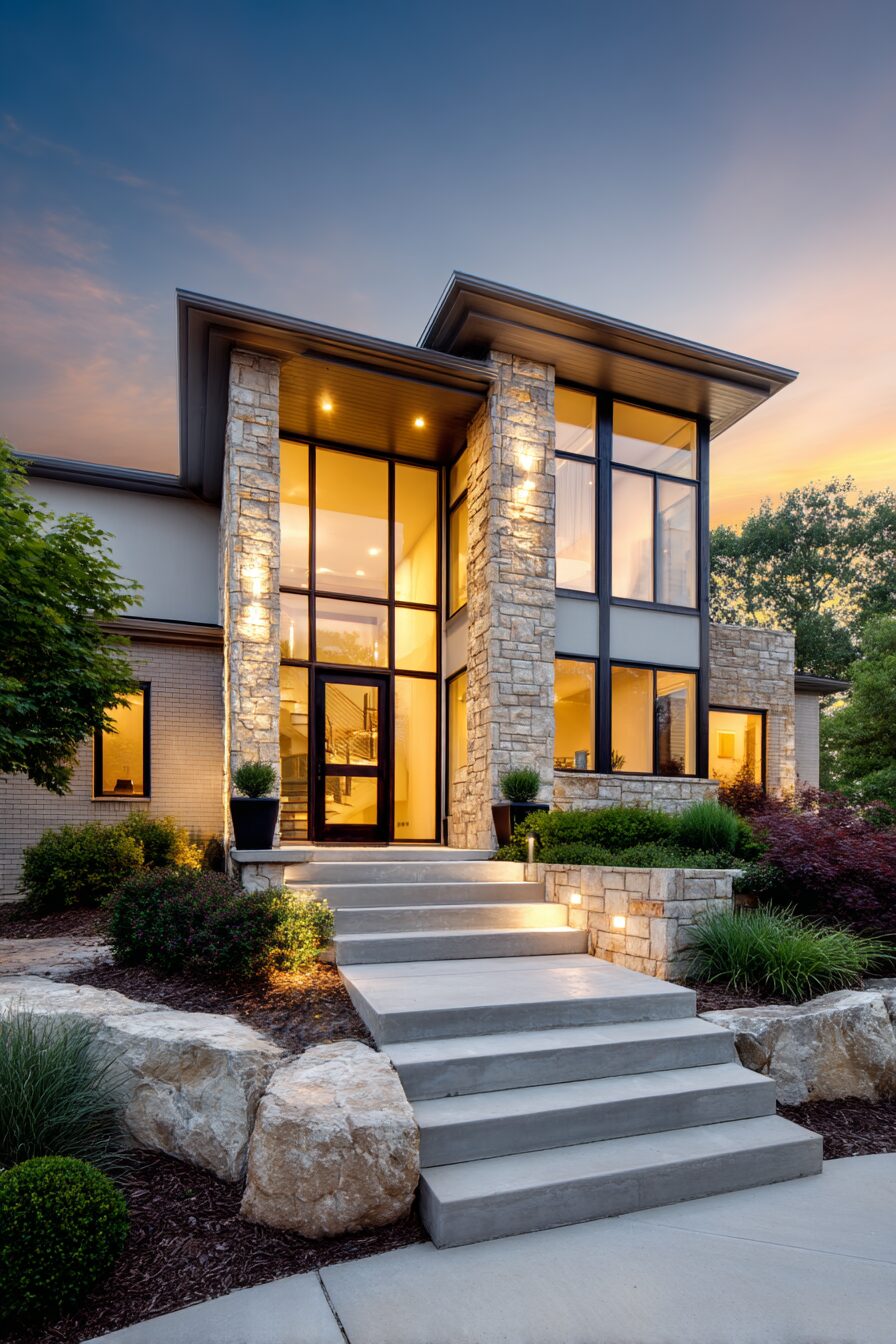Split-level homes, those architectural staples of mid-century neighborhoods, can sometimes feel stuck in a time warp.
But with the right exterior updates, your split-level can transform from dated to contemporary without losing its unique character.
Here are top ideas that will help you reimagine your home’s exterior, boosting both curb appeal and property value while turning heads in your neighborhood.
Mixed Material Facades for Textural Drama
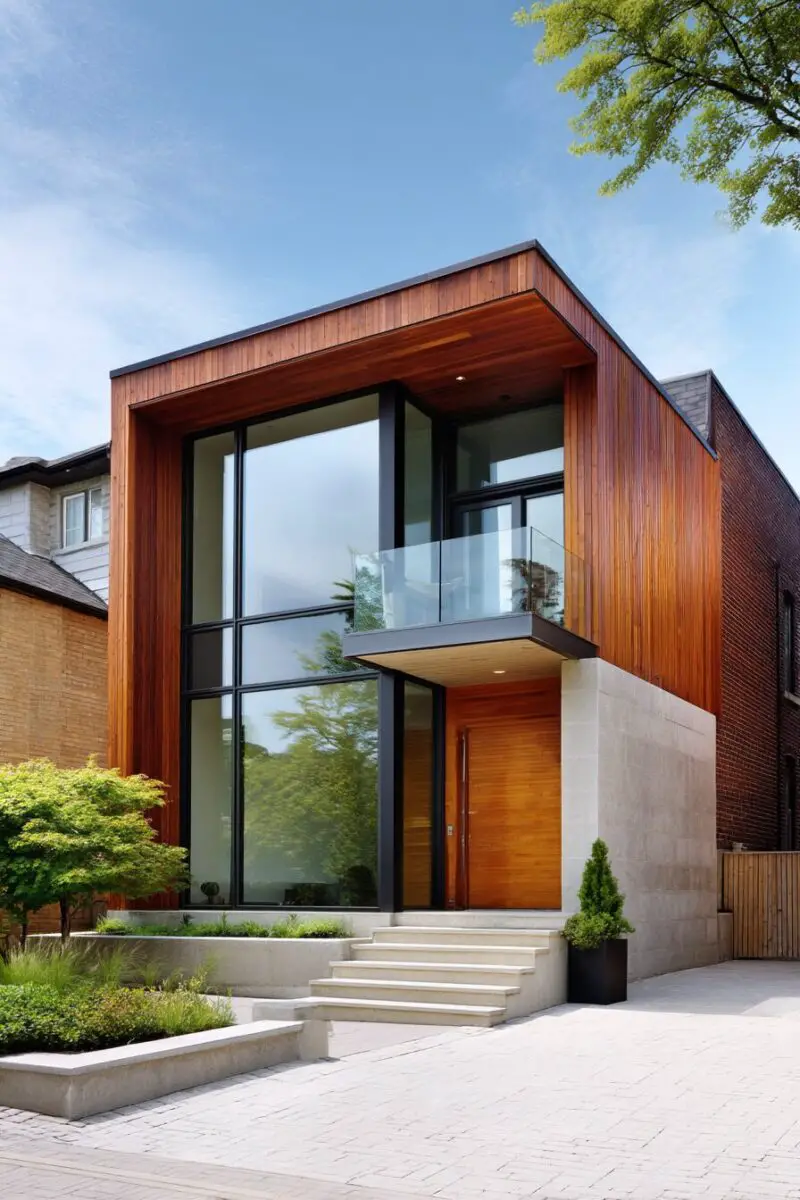
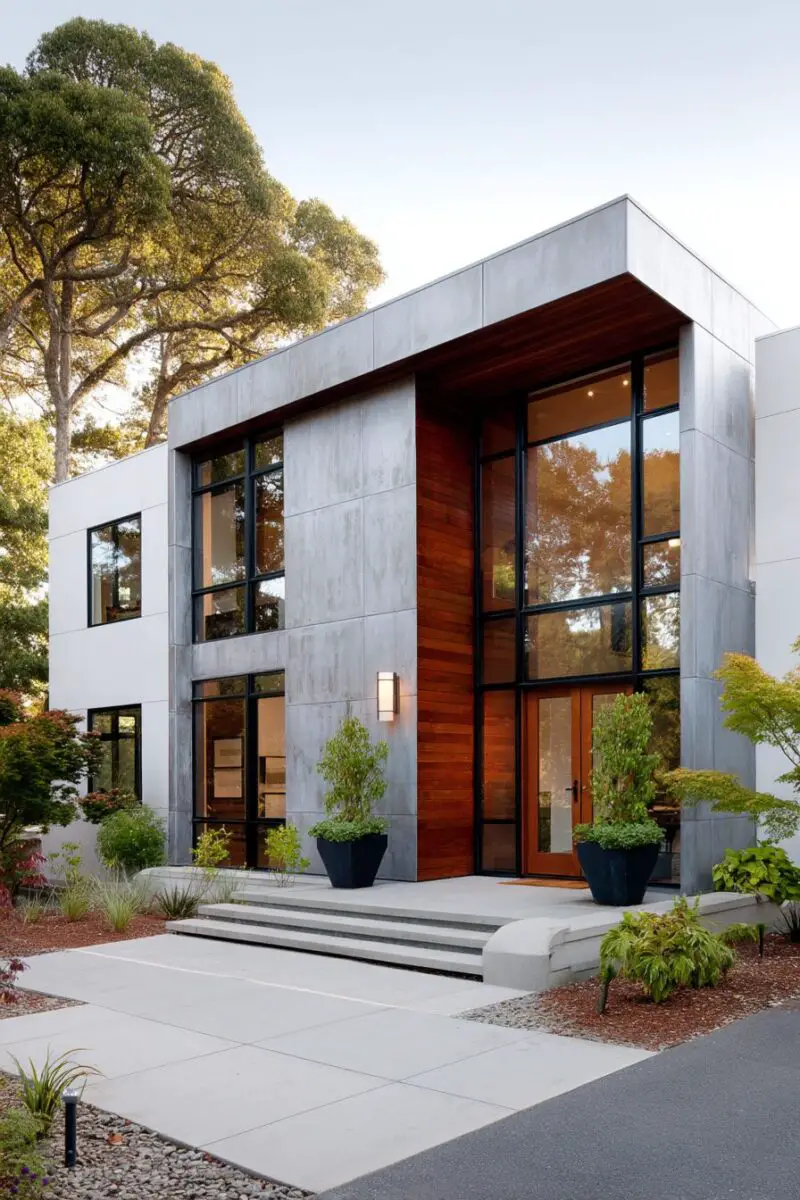
Nothing says “modern upgrade” quite like a thoughtfully designed mixed material facade.
By strategically combining materials like fiber cement, natural wood, stone veneer, and metal panels, you can break up the traditional split-level’s boxy appearance.
This approach creates visual interest through contrasting textures and depths that catch light differently throughout the day.
Natural stone or manufactured stone veneer can anchor the lower level, creating a solid base that visually grounds the home.
The key is choosing materials that complement rather than compete with each other.
For maximal impact, limit your palette to three materials that share undertones but offer contrasting textures.
This technique works especially well to highlight architectural features unique to split-levels, like the slightly protruding upper floors or recessed entryways.
Installation costs vary widely depending on materials chosen, with fiber cement averaging $5-10 per square foot and natural stone veneer potentially reaching $25-30 per square foot installed.
The investment pays dividends in durability, with most premium facade materials offering 50+ years of service with minimal maintenance.
For budget-conscious renovators, consider using the premium materials on the front facade as focal points, while using less expensive complementary materials on side and rear elevations.
The visual punch of mixed materials works particularly well when you maintain consistent color themes throughout, allowing the textural differences to become the star of the show.
Reimagined Entryways That Make a Statement

Your entryway sets the tone for your entire home, yet many split-level entries feel awkward or underwhelming.
Transforming this space creates an immediate focal point that signals your home’s updated aesthetic.
A contemporary canopy or small roof extension over the entry creates architectural interest while providing practical protection from the elements.
For truly dramatic results, consider widening the entire entry area by removing walls to create a more generous approach to your front door.
Glass sidelights or transom windows increase natural light and create a more welcoming entry experience.
Modern materials like brushed metal, frameless glass, or architectural concrete can transform the entry steps and landing into a sculptural element rather than just a functional necessity.
Reconfiguring the approach path with wide, floating concrete steps or a gently sloping walkway can visually ground the entrance and improve the home’s proportions.
Distinctive house numbers, modern lighting fixtures, and architectural hardware in matte black or brushed brass instantly signal contemporary sensibilities.
For split-levels with the typical recessed entry, consider bringing the entrance forward with a small addition that creates a more substantial presence.
This modification often provides the added benefit of creating a proper mud room or expanded foyer inside—addressing a common complaint about traditional split-level layouts.
The investment ranges from affordable door replacements (starting around $2,000-3,000 installed) to more substantial architectural modifications ($10,000-25,000), but few updates make as dramatic a difference to your home’s curb appeal.
When planning your entry renovation, consider how interior and exterior modifications might work together to improve both flow and appearance.
Design Your Dream Room in Minutes!
🏡 Start Creating FREE →Bold Color Strategies That Pop Against the Landscape
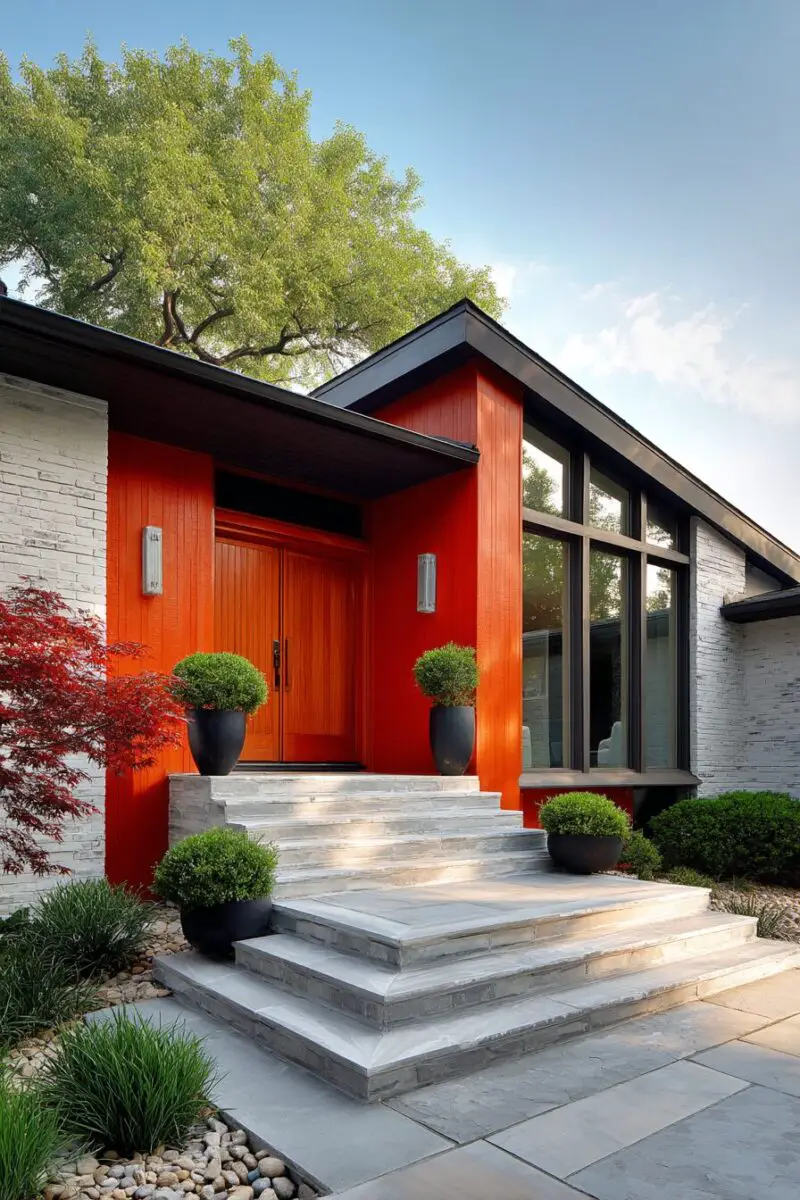
Traditional split-levels often feature dated color schemes that instantly age the architecture.
A thoughtful color update can be the most cost-effective way to modernize your home’s entire appearance.
Today’s contemporary homes embrace contrasting color schemes that highlight architectural features rather than trying to make them disappear.
White or light-colored trim creates crisp definition that emphasizes clean lines and architectural details.
For a truly contemporary approach, consider eliminating contrasting trim altogether in favor of a monochromatic scheme that creates a sleek, unified appearance.
Strategic pops of unexpected color—perhaps on the front door, window frames, or architectural accents—create focal points that draw the eye where you want attention.
Black-framed windows have become a modern exterior staple, creating dramatic contrast against lighter facades or blending seamlessly with darker exteriors.
When selecting colors, examine how they appear at different times of day and consider how they’ll interact with your landscaping throughout the seasons.
Modern split-level color schemes often incorporate natural elements like wood or stone in their natural colors as counterpoints to painted surfaces.
Don’t forget your roof—upgrading to architectural shingles in a complementary color can transform your home’s silhouette and add substantial depth to your color strategy.
Painting costs typically range from $5,000-12,000 for a full exterior, making this update significantly more affordable than structural changes while still delivering dramatic results.
Window Transformations That Frame Your Views
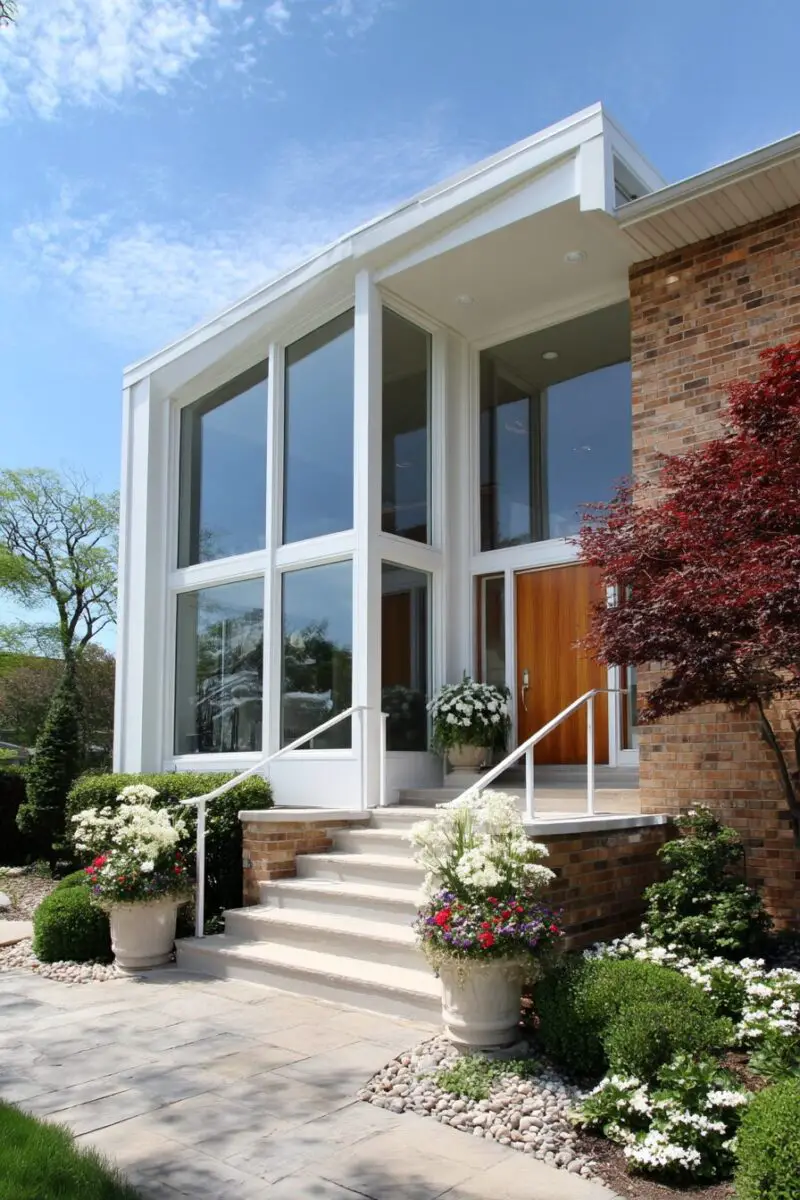
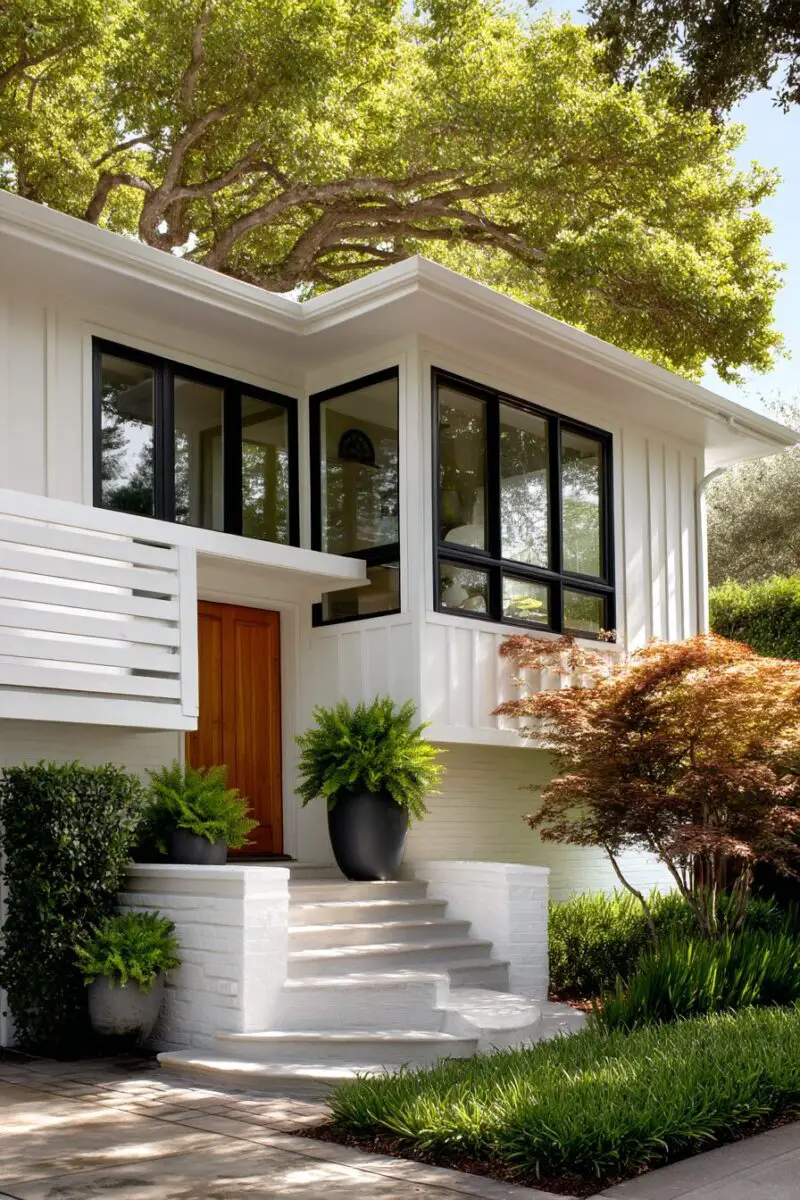
Split-level homes often feature outdated windows that date the entire structure and perform poorly in terms of energy efficiency.
Replacing these with contemporary window styles instantly modernizes your home’s appearance while improving comfort and reducing utility bills.
Black-framed windows in aluminum or fiberglass offer clean lines and improved durability compared to traditional vinyl or wood.
For a truly contemporary look, consider casement windows that offer uninterrupted glass areas rather than double-hung styles with muntins and multiple panes.
Corner windows or ribbon windows (a series of windows installed side by side) can dramatically alter your home’s appearance and create interesting architectural moments.
Floor-to-ceiling windows in living areas create dramatic interior-exterior connections that feel thoroughly modern.
In bedrooms or bathrooms, consider clerestory or transom windows that provide light and views while maintaining privacy.
Window replacements typically cost between $700-1,500 per opening depending on size and quality, with custom configurations commanding premium prices.
Energy-efficient models with low-E coatings and insulated frames can qualify for utility rebates or tax incentives that offset some costs while delivering ongoing energy savings.
When planning window updates, consider not just the windows themselves but also the surrounding trim and siding details that frame them.
Simple, clean trim profiles or windows installed directly to the siding without visible trim create the cleanest, most contemporary appearance.
The significant expense of window replacement is justified by the dual benefits of aesthetic improvement and practical performance upgrades that make this modification a smart investment in your home’s value.
Roofline Modifications That Elevate Everything
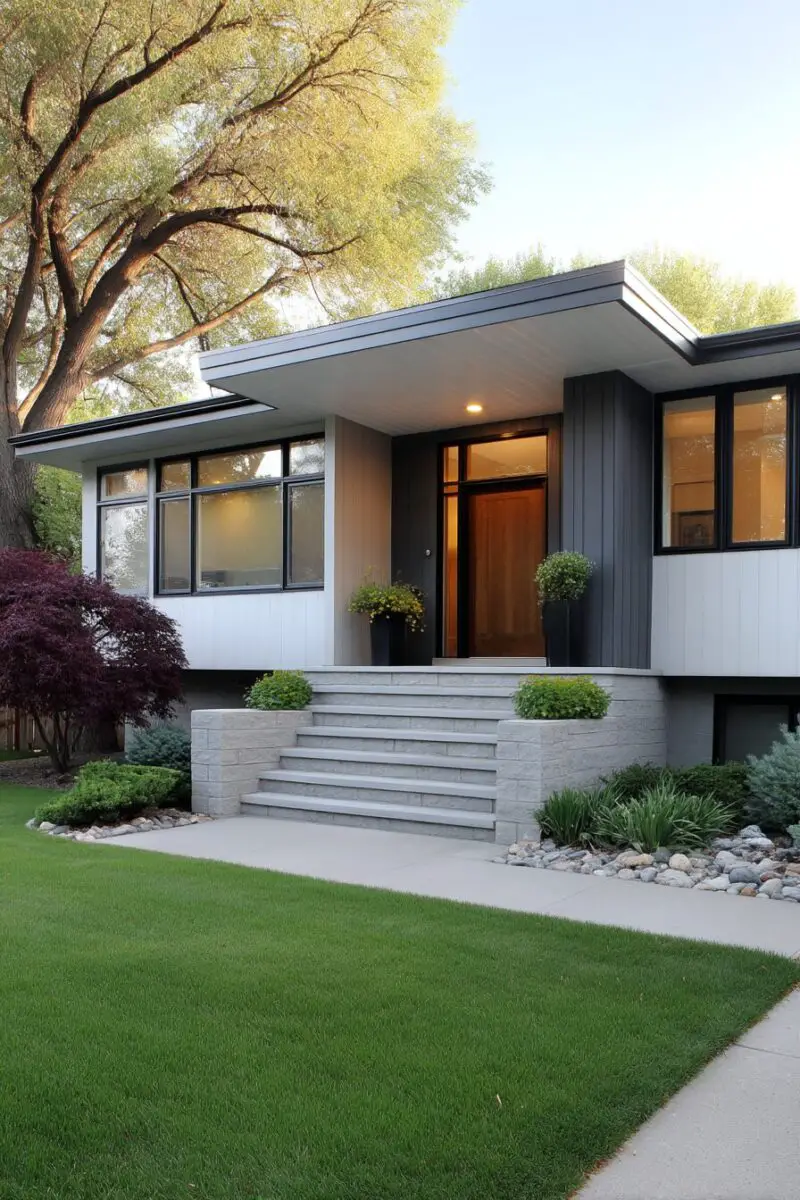
The horizontal rooflines typical of many split-level homes can look dated and fail to create visual interest.
Strategic roofline modifications can dramatically transform your home’s silhouette and overall architectural presence.
Extending roof overhangs creates shadow lines that add depth and dimension while offering practical benefits like improved weather protection and energy efficiency.
For a bold update, a partial second-story addition over one section of the home creates dramatic asymmetry that feels intentionally modern rather than dated.
Even modest changes like adding a shed roof over the entryway can create architectural interest that draws the eye upward.
Replacing outdated roofing materials with architectural shingles, standing seam metal, or even flat membrane roofing can completely transform the home’s appearance.
Contemporary rain screening systems that extend slightly beyond the roofline create clean, knife-edge details that signal architectural intentionality.
A pergola or trellis structure that extends from the facade creates the impression of an altered roofline without the expense of structural changes to the actual roof.
These modifications typically cost between $15,000-50,000 depending on complexity, but they fundamentally transform your home’s architectural identity.
Working with an architect or designer who specializes in residential renovations can help you identify the most impactful roofline changes for your specific home.
When planning roofline modifications, consider how interior spaces might be enhanced by these changes—perhaps through vaulted ceilings or additional upper-level square footage.
Though among the more expensive exterior updates, roofline modifications create such dramatic transformations that they often become the foundation for a comprehensive modernization strategy.
Outdoor Living Spaces That Expand Your Home’s Footprint

Modern homes seamlessly blend indoor and outdoor living, an approach that can eliminate the compartmentalized feel common to split-level designs.
Creating purposeful outdoor living areas that visually connect to the interior transforms how your home functions and appears from the street.
Covered outdoor rooms with features like outdoor kitchens, fire features, or media areas create usable square footage that extends your home’s living space.
Modern materials like composite decking, architectural concrete, and powder-coated aluminum railings with glass infill panels create outdoor spaces that feel as finished as interior rooms.
Thoughtfully integrated lighting ensures these spaces remain usable and attractive after dark, highlighting architectural features while providing practical illumination.
Pergolas or shade structures with retractable canopies or louvered roofs extend the usability of outdoor spaces throughout the seasons.
Front-yard patios or conversation areas can transform the approach to your home while creating useful social spaces that encourage neighborhood interaction.
Built-in seating, planters, and storage eliminate the need for movable furniture that can look cluttered and impermanent.
Connecting these outdoor spaces to the interior through expanded doorways, sliding glass walls, or French doors strengthens the indoor-outdoor relationship.
These additions typically cost between $20,000-60,000 depending on size, materials, and features, but they add valuable living space at a lower cost per square foot than interior renovations.
When designing outdoor living areas, consider how they’ll be viewed both from the street and from within your home—the most successful spaces enhance both perspectives.
The substantial visual impact of well-designed outdoor living areas can completely transform how people perceive your split-level home, shifting focus from dated architectural elements to contemporary lifestyle amenities.
TRENDING NOW
Modern Fence Toppers To Elevate Your Outdoor SpaceLandscape Redesign for Architectural Enhancement

Split-level homes often suffer from outdated foundation plantings that emphasize rather than minimize the home’s awkward proportions.
A comprehensive landscape redesign can dramatically alter your home’s appearance by creating intentional sight lines and focal points.
Raised planters with clean, geometric forms add contemporary elements while bringing plantings up to visually balance the home’s vertical proportions.
For split-levels built on sloped lots, terraced landscaping with retaining walls creates usable outdoor spaces while turning the slope into an asset rather than a challenge.
Contemporary materials like Corten steel, board-formed concrete, or architectural stone add texture and visual interest to the landscape.
Strategic tree placement can shield unsightly elements or create privacy without completely hiding your newly updated facade.
Simplified plant palettes with masses of the same species create bold, contemporary visual impact rather than the hodgepodge appearance of traditional suburban landscaping.
Reducing lawn areas in favor of native plantings, gravel gardens, or hardscaped spaces creates both visual interest and environmental benefits.
Professional landscape design services typically cost $2,000-5,000, with implementation ranging from $15,000-50,000 depending on the scope of hardscaping and planting.
When planning landscape updates, consider four-season interest and how the plantings will mature over time—the most successful landscapes look intentional throughout the year and as plants reach maturity.
Though often overlooked in renovation budgets, thoughtful landscaping can dramatically transform your property while creating the perfect frame for your home’s newly updated architecture.
Garage Door Upgrades for Instant Modernization

On many split-level homes, the garage door occupies a significant portion of the facade, making outdated doors an immediate visual liability.
Contemporary garage door designs can transform this functional element into an architectural feature that enhances your home’s overall appearance.
For a more subtle approach, flush-panel doors without raised panels or decorative elements create clean lines that complement modern aesthetics.
Materials like wood, aluminum, or composite offer alternatives to traditional steel doors, adding warmth and texture to your facade.
Custom colors that either match your home’s exterior or purposefully contrast with it transform the garage from afterthought to intentional design element.
Smart-home integration with WiFi-enabled openers, integrated cameras, and lighting controls adds contemporary functionality that matches the updated appearance.
If your garage is prominently positioned, consider architectural details like reveal lines, integrated lighting, or hardware upgrades that elevate this utilitarian feature.
Painting the garage door a dark color that recedes visually can minimize its prominence on the facade—particularly effective when the entry door receives a brighter accent color.
New garage doors typically cost $2,000-5,000 installed, making this one of the most cost-effective exterior updates with immediate visual impact.
When selecting a new garage door, consider how it will coordinate with other exterior elements like entry doors, windows, and facade materials.
The right garage door can transform the entire streetside appearance of your home, creating a contemporary look even if other updates must wait for future renovation phases.
For split-levels with front-facing garages, this single update often delivers the biggest bang for your renovation buck, instantly modernizing the home’s appearance.
Architectural Lighting That Showcases Your Updates
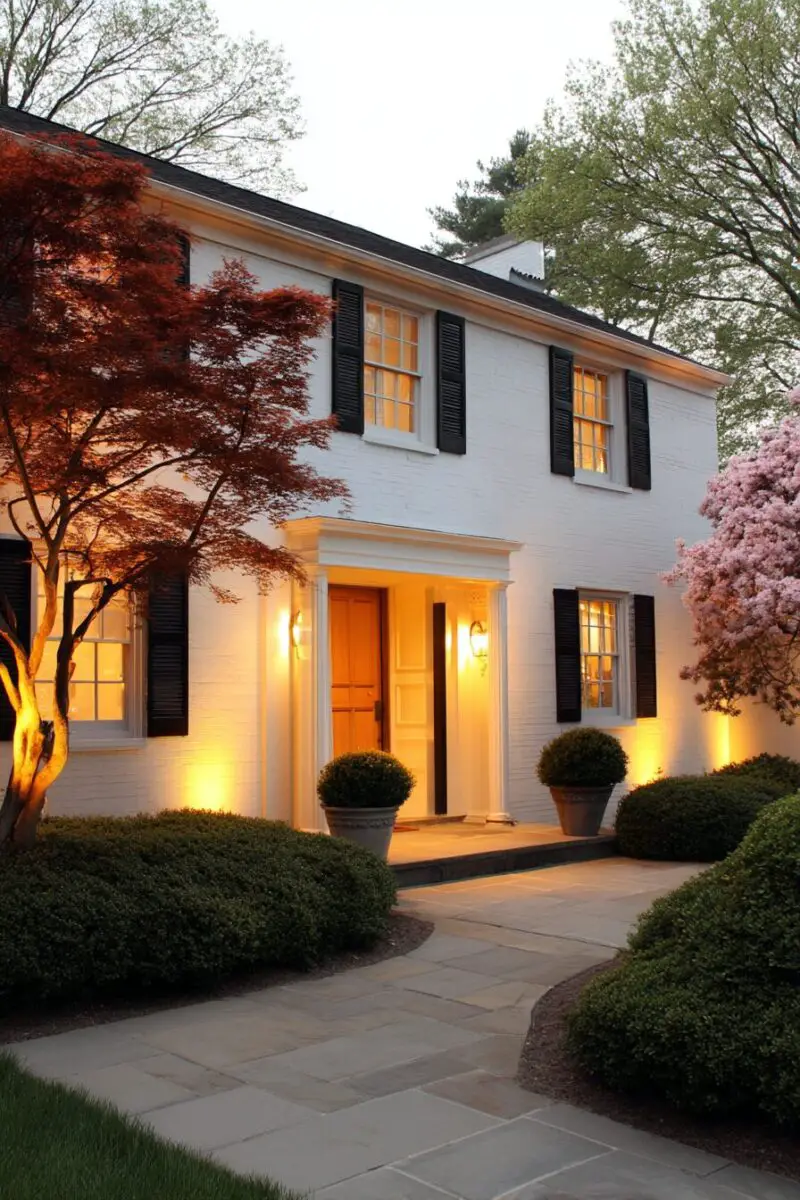
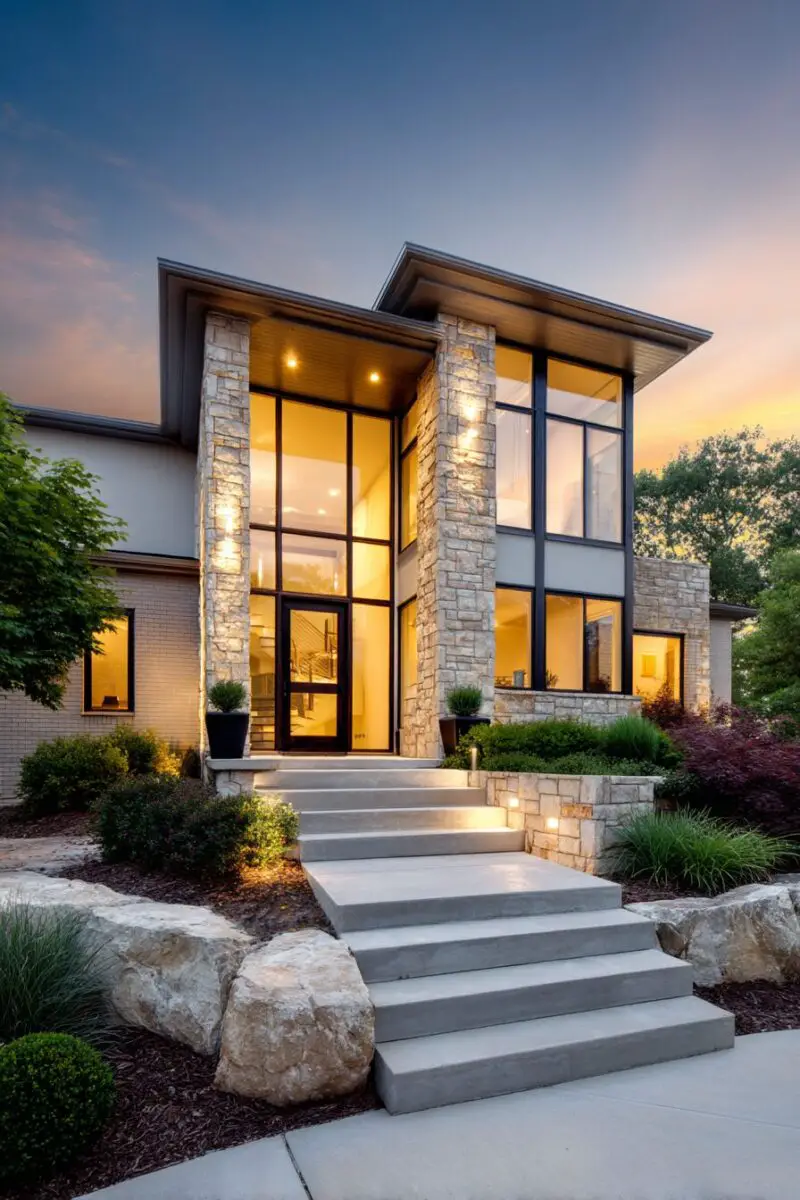
Outdated or inadequate exterior lighting can undermine even the most thoughtful architectural updates.
Contemporary lighting strategies highlight your home’s best features while providing security and functionality after dark.
Path lighting with hidden light sources creates pools of light that guide visitors to your entrance without visible fixtures that interrupt the landscape.
Strategically placed uplights highlight architectural features, specimen trees, or garden elements that might go unnoticed during daylight hours.
LED strip lighting concealed under stair treads, handrails, or bench seating creates a floating effect that feels thoroughly modern.
Smart lighting systems allow programmable scenes, color-changing capabilities, and integration with home automation for convenience and energy efficiency.
Step lights inset into retaining walls or risers illuminate transitions between levels for safety while creating a hospitality-inspired ambiance.
Modern fixture designs in clean, architectural forms become visual elements themselves rather than merely functional necessities.
A comprehensive lighting plan typically costs $3,000-10,000 installed depending on fixture quality and complexity, with LED options offering long-term energy savings.
When planning lighting updates, consider both the view from the street and how lighting enhances your experience of outdoor spaces after dark.
Though often overlooked in renovation budgets, architectural lighting dramatically extends the impact of your exterior updates beyond daylight hours, creating a completely different experience of your home at night.
TRENDING NOW
Stunning Cement DIY Projects for Your HomeSustainable Updates That Signal Contemporary Values
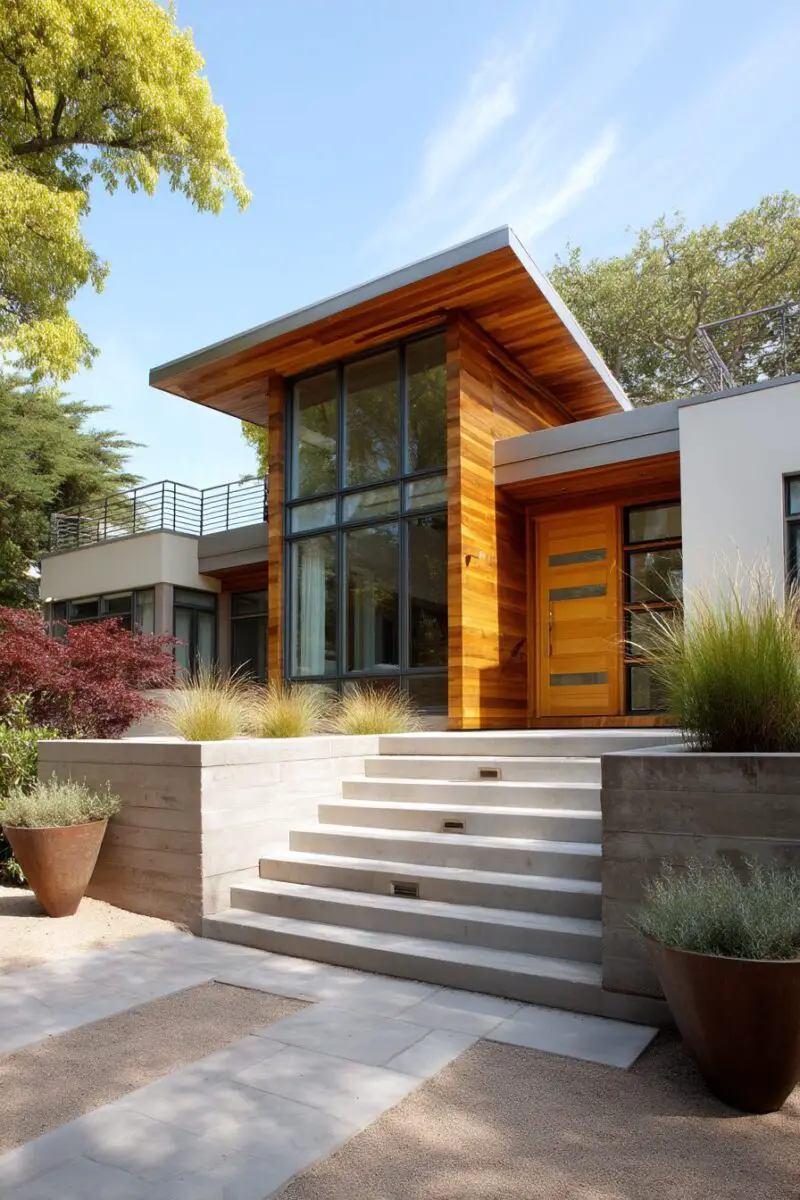

Modern home design increasingly incorporates sustainability features that reflect contemporary environmental awareness.
These practical updates not only reduce your environmental footprint but also signal your home’s updated, forward-thinking design philosophy.
Rainwater collection systems with architectural water features transform stormwater management into a design element rather than merely functional infrastructure.
Green roof sections on flat roof areas create visual interest while improving insulation and managing stormwater.
Native and drought-tolerant landscaping reduces water consumption while creating habitat for local wildlife—a beautiful and responsible approach to exterior design.
Permeable paving for driveways and walkways allows water infiltration while offering more design flexibility than traditional concrete or asphalt.
Insulated facade systems improve energy efficiency while providing the opportunity to completely transform your home’s exterior appearance.
Smart irrigation systems with weather sensors ensure efficient water use while maintaining lush landscaping even during dry periods.
These sustainable features typically add a 10-20% premium to conventional construction costs but offer long-term utility savings and potential tax incentives.
When planning sustainable updates, prioritize those with visual impact that enhances your home’s appearance while delivering meaningful environmental benefits.
Beyond the practical benefits, these visible commitments to sustainability communicate your home’s thoroughly contemporary values, separating it from outdated properties that prioritize appearance over environmental performance.
Instead, these updates celebrate your home’s unique architecture while bringing it firmly into the present day.
Your reimagined split-level will not only provide improved functionality and efficiency but will also stand as a testament to thoughtful design that respects architectural history while embracing contemporary aesthetics.

